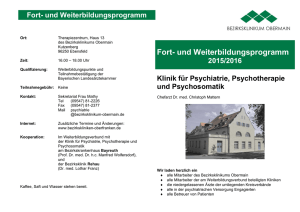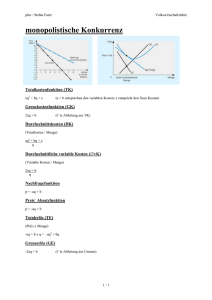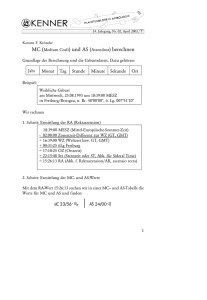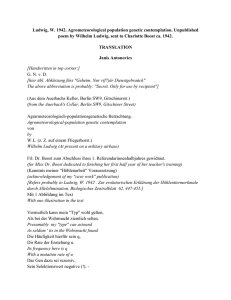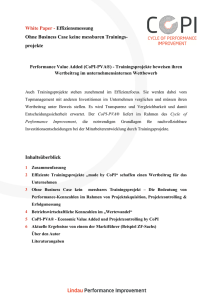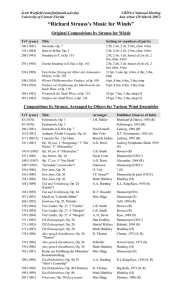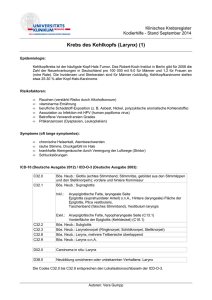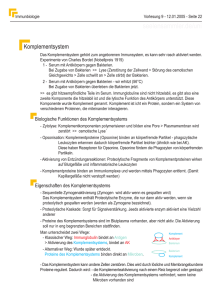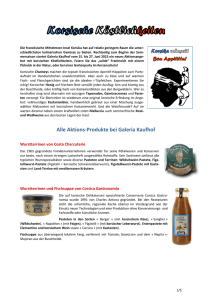PDF, 374 KB
Werbung
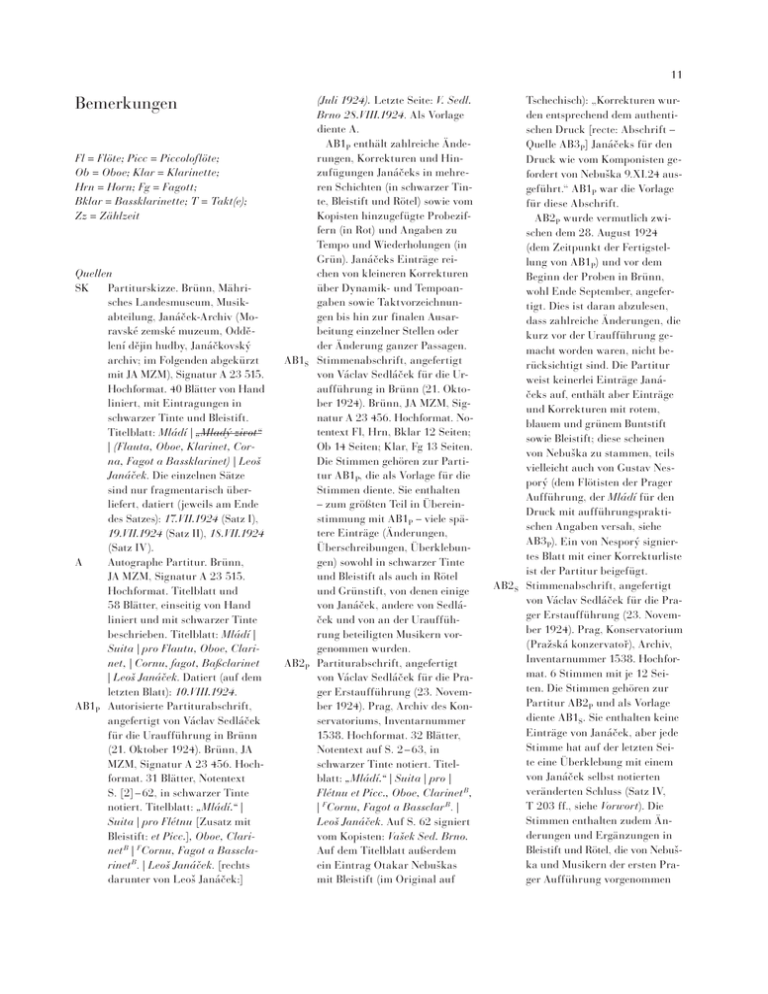
11 Bemerkungen Fl = Flöte; Picc = Piccoloflöte; Ob = Oboe; Klar = Klarinette; Hrn = Horn; Fg = Fagott; Bklar = Bassklarinette; T = Takt(e); Zz = Zählzeit Quellen SK Partiturskizze. Brünn, Mähri­ sches Lan­desmuseum, Musik­ abteilung, Ja­ná­c ek-Archiv (Mo­ ravské zemské muzeum, Odde­ lení dejin hudby, Janáckovský archiv; im Folgenden abgekürzt mit JA MZM), Signatur A 23 515. Hochformat. 40 Blätter von Hand liniert, mit Eintragungen in schwarzer Tinte und Bleistift. Titelblatt: Mládí | „Mladý zivot“ | (Flauta, Oboe, Klarinet, Cor­ na, Fagot a Bassklarinet) | Leoš Ja­ná ­cek. Die einzelnen Sätze sind nur fragmentarisch über­ liefert, datiert (jeweils am Ende des Satzes): 17.VII.1924 (Satz I), 19.VII.1924 (Satz II), 18.VII.1924 (Satz IV). A Autographe Partitur. Brünn, JA MZM, Signatur A 23 515. Hochformat. Titelblatt und 58 Blätter, einseitig von Hand ­l iniert und mit schwarzer Tinte beschrieben. Titelblatt: Mládí | Suita | pro Flautu, Oboe, Clari­ net, | Cornu, fagot, Baßclarinet | Leoš Ja­ná­cek. Datiert (auf dem letzten Blatt): 10.VIII.1924. AB1P Autorisierte Partiturabschrift, angefertigt von Václav Sedlácek für die Uraufführung in Brünn (21. Oktober 1924). Brünn, JA MZM, Signatur A 23 456. Hoch­ format. 31 Blätter, Notentext S. [2] – 62, in schwarzer Tinte notiert. Titelblatt: „Mládí.“ | Suita | pro Flétnu [Zusatz mit Bleistift: et Picc.], Oboe, Clari­ net B | F Cornu, ­Fagot a Basscla­ rinet B. | Leoš Ja­ná­cek. [rechts darunter von Leoš Ja­ná­c ek:] (Juli 1924). Letzte Seite: V. Sedl. Brno 28.VIII.1924. Als Vorlage diente A. AB1P enthält zahlreiche Ände­ rungen, Korrekturen und Hin­ zufügungen Ja ­ná­c eks in mehre­ ren Schichten (in schwarzer Tin­ te, Bleistift und Rötel) sowie vom Kopisten hinzugefügte Probezif­ fern (in Rot) und Angaben zu Tempo und Wiederholungen (in Grün). Ja­ná­c eks Einträge rei­ chen von kleineren Korrekturen über Dynamik- und Tempoan­ gaben sowie Taktvorzeichnun­ gen bis hin zur finalen Ausar­ beitung einzelner Stellen oder der Änderung ganzer Passagen. AB1S Stimmenabschrift, angefertigt von Vác­lav Sedlácek für die Ur­ aufführung in Brünn (21. Okto­ ber 1924). Brünn, JA MZM, Sig­ natur A 23 456. Hochformat. No­ tentext Fl, Hrn, Bklar 12 Seiten; Ob 14 Seiten; Klar, Fg 13 Seiten. Die Stimmen gehören zur Parti­ tur AB1P, die als Vorlage für die Stimmen diente. Sie enthalten – zum größten Teil in Überein­ stimmung mit AB1P – viele spä­ tere Einträge (Änderungen, Überschreibungen, Überklebun­ gen) sowohl in schwarzer Tinte und Bleistift als auch in Rötel und Grünstift, von denen einige von Ja­ná­c ek, andere von Sed­lá­ cek und von an der Urauffüh­ rung beteiligten Musikern vor­ genommen wurden. AB2P Partiturabschrift, angefertigt von Václav Sedlácek für die Pra­ ger Erstaufführung (23. Novem­ ber 1924). Prag, Archiv des Kon­ servatoriums, Inventarnummer 1538. Hochformat. 32 Blätter, Notentext auf S. 2 – 63, in schwarzer Tinte notiert. Titel­ blatt: „Mládí.“ | Suita | pro | Flétnu et Picc., Oboe, Clarinet B , | F Cornu, Fagot a Bassclar B. | Leoš Ja­ná ­cek. Auf S. 62 signiert vom Kopisten: Vašek Sed. Brno. Auf dem Titelblatt außerdem ein Eintrag Otakar Ne­buš­kas mit Bleistift (im Original auf Tschechisch): „Korrekturen wur­ den entsprechend dem authenti­ schen Druck [recte: Abschrift – Quelle AB3P] Ja­ná­c eks für den Druck wie vom Komponisten ge­ fordert von Ne­buš­ka 9.XI.24 aus­ geführt.“ AB1P war die Vorlage für diese Abschrift. AB2P wurde vermutlich zwi­ schen dem 28. August 1924 (dem Zeitpunkt der Fertigstel­ lung von AB1P) und vor dem Beginn der Proben in Brünn, wohl Ende September, angefer­ tigt. Dies ist daran abzulesen, dass zahlreiche Änderungen, die kurz vor der Uraufführung ge­ macht worden waren, nicht be­ rücksichtigt sind. Die Partitur weist keinerlei Einträge Ja­ná­ ceks auf, enthält aber Einträge und Korrekturen mit rotem, blauem und grünem Buntstift sowie Bleistift; diese scheinen von Ne­buš­ka zu stammen, teils vielleicht auch von Gustav Nes­ porý (dem Flötisten der Prager Aufführung, der Mládí für den Druck mit aufführungsprakti­ schen Angaben versah, siehe AB3P). Ein von Nesporý signier­ tes Blatt mit einer Korrekturliste ist der Partitur beigefügt. AB2 S Stimmenabschrift, angefertigt von ­Václav Sedlácek für die Pra­ ger Erstaufführung (23. Novem­ ber 1924). Prag, Konservatorium (Pražská kon­zer­vator), Archiv, Inventarnummer 1538. Hochfor­ mat. 6 Stimmen mit je 12 Sei­ ten. Die Stimmen gehören zur Partitur AB2P und als Vorlage diente AB1S. Sie enthalten keine Einträge von Ja­ná­c ek, aber jede Stimme hat auf der letzten Sei­ te eine Überklebung mit einem von Ja­ná­c ek selbst notierten ­veränderten Schluss (Satz IV, T 203 ff., siehe Vorwort). Die Stimmen enthalten zudem Än­ derungen und Ergänzungen in Bleistift und Rötel, die von Ne­buš­ ka und Musikern der ersten Pra­ ger Aufführung vorgenommen 12 wurden, größtenteils in Überein­ stimmung mit AB2P and AB3P. AB3P Autorisierte Partiturabschrift, angefertigt von Václav Sedlácek, Stichvorlage für die Erstausga­ be. Brünn, JA MZM, Signatur A 48 559. Hochformat. 32 Blät­ ter, Notentext S. 2 – 63, in schwar­ zer Tinte notiert. Titelblatt (in Tinte): Mládí | Suita | pro Flét­ nu et Picc., Oboe, Clarinet B , | CornuF, Fagot a Bassclar B | Leoš Ja­ná ­cek. Ne­buš­ka korri­ gierte die Besetzung (mit Blei­ stift) zu Flétna (Picc.), Oboe, Cla­ ri­net B , | Corna F, Fagot a Bass­ clar B und fügte (1924) hinzu. Auf Seite 63: Vašek Sedl. Brno 1924. Auf dem Titelblatt außer­ dem verschiedene Einträge von Ne­buš­ka (im Original auf Tsche­ chisch): „Authentische Fassung, die mir der Komponist Ja­ná­c ek für den Druck und als Vorlage zur Korrektur anderer Partitu­ ren und Stimmen überreichte. Brünn, den 6.XI.1924, am Tag der Uraufführung des Schlauen Füchsleins. Otakar Ne­buš­ka“, und „Korrigiert von Ja­ná­c ek am 21.XI. vor der ersten Prager (und ersten öffentlichen) [sic] Aufführung am Sonntag, den 23.XI.24, mit 7 Bläsern der Tschechischen Philharmonie in einem Konzert mit neuen Wer­ ken der Hud[ební] M[atice]. Am 25.XI. im Parlament abschlie­ ßend überarbeitet durch den Flötisten der Tschechischen Philharmonie Nesporý (der für die Proben zuständig war) sowie durch Ne­buš­ka.“ Für die Parti­ tur diente AB1P als Vorlage; an­ gefertigt wurde die Partiturab­ schrift aber sicher erst nach den Proben in Brünn, denn sie ent­ hält bereits zahlreiche für die Brünner Uraufführung vorge­ nommene Änderungen. Spätere Änderungen Ja ­ná­c eks in AB1P sind jedoch ­offensichtlich nicht berücksichtigt. Folglich entstand AB3P vermutlich zwischen dem 21. Oktober 1924 (Brün­ner Ur­ aufführung) und dem 6. Novem­ ber 1924, dem Zeitpunkt, als ­Ja­ná­c ek die Abschrift Otakar Ne­buš­ka übergab. Zusätzlich zu den Angaben für die Druck­legung in Blau und Rot enthält die Partitur viele aufführungspraktische Eintra­ gungen mit Bleistift von Ne­buš­ ka und vermutlich auch von Nesporý. Von Ja­ná­c ek finden sich keine Eintragungen. Daher ist anzunehmen, dass sich die auf dem Titelblatt beschriebe­ ne Autorkorrektur nur auf so grundlegende Änderungen wie die Tempo- und Metronoman­ gaben bezieht, die Ja­ná­c ek mit Ne­buš­ka diskutiert hatte. Die zahlreichen Detailkorrekturen in Dynamik, Phrasierung etc. dagegen wurden in der Partitur erst nachträglich (von Ne­buš­ka und Nesporý) und ohne eine di­ rekte Einflussnahme Ja­ná­c eks vorgenommen. E Erstausgabe, Studienpartitur. Prag, Hudební matice Umelecké besedy, Plattennummer „H. M. 341“, erschienen 1925. Titel: Leoš Ja n ­ ácek | (1924) | MLÁDÍ | Suita pro dechové nástroje | ­J UGEND – LA JEUNESSE – YOUTH | Suite pour instruments à vent: | flauto (piccolo), oboe, clarinetto, corno, fagotto, | cla­ rinetto basso | PARTITURA | PRAHA 1925 | HUDEBNÍ MA­ TICE UMELECKÉ BESEDY | Paris: MAX ESCHIG & Cie. – London: J. & W. CHESTER Ltd. | Leipzig: BREITKOPF & HÄR­ TEL. | (341). Stichvorlage war AB3P, aber E enthält nicht alle aufführungspraktischen Eintra­ gungen, die in AB3P vorgenom­ men wurden. Weder Ja­ná­c eks Korrekturabzug noch sein Hand­ exemplar der Partitur haben sich erhalten. Verwendetes Exemplar: Brünn, JA MZM, Signatur T-I-41. Erstausgabe, Stimmen. Prag, E S Hudební matice Umelecké bese­ dy, Plattennummer „H. M. 347“, erschienen 1925. Titel wie in E. Stichvorlage war AB3P, viele der darin von Nesporý vorgenomme­ nen Eintragungen, die nicht in die gedruckte Partitur E eingin­ gen, wurden in den Stimmen berücksichtigt. Verwendetes Ex­ emplar: Prag, Nationalbiblio­ thek der Tschechischen Re­publik (Ná­rodní knihovna Ceské repu­ bliky), Musikabteilung, Signa­ tur cnb001889694. Zur Edition Aus den im Vorwort ausführlich darge­ legten Gründen werden für die Edition von Mládí mehrere Abschriften heran­ gezogen: AB1P und AB1S bilden die Grundlage der Edition, die Stichvor­ lage AB3P dient als weitere wichtige Quelle. Das Autograph A, das ein frü­ heres Werkstadium repräsentiert, wird nur an fraglichen Stellen zurate gezo­ gen. AB2P und AB2 S sowie E wurden vollständig mit den anderen Quellen verglichen. Fehler oder Auslassungen in AB1P oder AB1S werden stillschweigend ge­ mäß der jeweils anderen Quelle korri­ giert bzw. ergänzt. Gemäß AB2P, AB2 S und AB3P werden Fehler und Auslas­ sungen in AB1P und AB1S (die zum Teil auf die starke Überarbeitung dieser Quellen zurückgehen) korrigiert und die von Ja­ná­c ek in AB3P gebilligten Änderungen in den Haupttext der Par­ titur übernommen. Diese Änderungen gemäß AB3P werden in den Einzelbe­ merkungen erwähnt. Die zahlreichen weiteren Änderungen und Ergänzun­ gen von Ne­buš­ka in AB3P, die eine de­ tailliert ausgearbeitete Dynamik, Arti­ kulation und Phrasierung betreffen und wahrscheinlich nicht auf Ja­ná­c ek zurückgehen, sondern erst auf Nespo­ rýs Anregung in die Partitur kamen, werden nur in den Einzelbemerkun­ gen aufgelistet. Musikalisch relevante Abweichungen unserer Ausgabe von EP werden durch Fußnoten im Notentext gekennzeichnet und in den Einzelbe­ merkungen erwähnt. In den seltenen Fällen, wo ein in den abschriftlichen Quellen fehlendes Zeichen gemäß EP ergänzt werden konnte, wird dies eben­ 13 falls in den Einzelbemerkungen er­ wähnt. Frühere Varianten, die aus dem Ver­ gleich der Quellen zu erkennen sind, werden nur dort erwähnt, wo Unsicher­ heit über die endgültige Version besteht oder neben dieser noch eine weitere durch Ja ­ná­c ek autorisiert sein könnte. Sofern sie Alternativen für die Auffüh­ rung betreffen, werden sie in Fuß­noten oder als Ossia im Notentext wiederge­ geben. Schreib- und Druckfehler in den Hauptquellen werden stillschweigend korrigiert. Dynamikangaben und Aus­ drucksbezeichnungen, die in der Parti­ tur nicht für jedes Instrument notiert sind, aber für alle Instrumente oder gewisse Instrumentengruppen gelten, wurden auf diese übertragen. Enhar­ monische Verwechslungen wurden, im Hinblick auf Ja­ná­c eks modales Den­ ken, nur in Ausnahmefällen (aus prak­ tischen Gründen) vorgenommen. Die in den Quellen mitunter verwirrende Schreibweise von Duolen, Triolen etc. wurde den modernen Regeln gemäß normiert: Wird z. B. in einem 3/8-, 6/8oder 9/8-Takt der Wert von 3 Achtel­ noten in eine Quartole oder Quintole unterteilt, ist diese Notengruppe wie­ derum in (4 oder 5 statt 3) Achtelno­ ten dargestellt; die Notation einer Duole im 3/8-Takt wird hingegen mit (2 statt einer) Viertelnoten geschrieben. Diese Regelung gilt für alle analogen Situa­ tionen. Die im Bassschlüssel notierte Bassklarinette (= deutsche Notation) wurde gemäß heute üblicher (französi­ scher) Notation in den oktavierend zu lesenden Violinschlüssel übertragen (sie klingt also um eine None tiefer als no­ tiert). Die in runden Klammern wieder­ gegebenen zusätzlichen Angaben zum Tempo (wie etwa a una battuta) ent­ stammen den Quellen; alle weiteren in runde Klammern gesetzten Zeichen stellen Ergänzungen des Herausgebers dar. Die nachfolgenden Einzelbemerkun­ gen umfassen nur die wesentlichen, für die musikalische Aufführung relevanten Lesarten; eine vollständige Auflistung (auf Englisch) ist auf www.henle.com als kostenloser Download abrufbar. Einzelbemerkungen I Allegro In allen Abschriften ursprünglich An­ dante d = 128. In AB2P, AB3P von Ne­buš­ka zu Allegro d = 144 geän­ dert. 6a/b Bklar: In allen Abschriften erneut mf. 13: In AB3P molto rit. (von Ne­buš­ka geändert). 23 Hrn, Bklar: mf gemäß AB3P (von Ne­buš­ka ergänzt). 31: In allen Abschriften ursprünglich ohne Metronomangabe. In AB1P a t[empo] von Ja­ná­c ek ergänzt, in AB2P a = 72 (von späterer Hand?), in AB3P a tempo gestrichen und a = 72 von Ne­buš­ka ergänzt. 36 Hrn: a z gemäß AB2P. 39: In allen Abschriften ursprünglich ohne Tempoangabe. In AB2P Tempo I ergänzt, in AB3P Tempo I d = 144 von Ne­buš­ka ergänzt. 57 Hrn: In AB3P (von Ne­buš­ka geän­ dert) und E 3. – 6. Note eine Oktave höher notiert. 58: In allen Abschriften ursprünglich ohne Metronomangabe. In AB2P, AB3P v = 160 von Ne­buš­ka ergänzt. 91 – 93 Klar: In E T 91 z , T 92 f. a. 93: In AB1P cresc. von Ja­ná­c ek ergänzt, in AB3P von Ne­buš­ka gestrichen. 96 Ob: In AB1P, AB1S, AB2P, AB2 S a. 99 – 101: In AB3P (von Ne­buš­ka geän­ dert) und E ritenuto poco a poco statt rit. in T 101. 102: In allen Abschriften ursprünglich ohne Metronomangabe. In AB1P a t[empo] von Ja­ná­c ek ergänzt; in AB3P a tempo von Ne­buš­ka gestri­ chen. In AB2P, AB3P v = 60 von Ne­ buš­ka ergänzt. 110: In allen Abschriften ursprünglich Tempo I mo, ohne Metronomangabe. In AB3P von Ne­buš­ka zu Meno mos­ so a = 72 geändert. 114: In allen Abschriften ursprünglich v = 128. In AB2P, AB3P a = 168 von Ne­buš­ka ergänzt. 120: In AB1P ursprünglich Allegro, von Ja­ná­c ek gestrichen. 123 Fl, Klar: a gemäß AB3P (in Fl vermutlich von Ne­buš­ka ergänzt). 132: In allen Abschriften ursprünglich ohne Tempoangabe. In AB2P v = 176 von Ne­buš­ka ergänzt; in AB3P Poco più mosso v = 176 von Ne­buš­ka er­ gänzt. 139 – 145 Ob, Klar: In AB1P, AB1S 2. und 3. Note im W-Motiv in Ob jeweils tenuto, in Klar ohne jegliche Artikulation. In AB3P (von Ne­buš­ka) nur in T 139 zu letzte Note staccato geändert. In unserer Ausgabe wur­ den dieser Änderung folgend die weiteren Staccatopunkte ergänzt. 162: In allen Abschriften ursprünglich ohne Metronomangabe. In AB2P v = 192 von Ne­buš­ka ergänzt; in AB3P v = 192 (à una battuta) von Ne­buš­ka ergänzt. 162 – 166 Klar, Hrn: In AB1P, AB1S, AB2P und AB3P ursprünglich die als Ossia wiedergegebene Variante, die Änderung zur späteren Variante wur­ de von Ja­ná­cek in AB1P angezeigt und auch in AB1S, AB2P, AB3P über­ tragen. In AB2S ist die spätere Vari­ ante bereits notiert, in E dagegen die frühere – was möglicherweise ein Hinweis darauf ist, dass Ja­ná­cek die­ se frühere Variante als endgültige ver­ stand (siehe dazu auch das Vorwort). II Andante sostenuto In allen Abschriften außer AB2 S ur­ sprünglich Moderato v = 92 (in AB1S Fl und Ob ohne Metronomangabe); in AB2P v = 72 von Ne­buš­ka ergänzt; in AB3P von Ne­buš­ka zu Andante sostenuto v = 72 geändert. 16: In allen Abschriften ursprünglich ohne Metronomangabe. In AB2P, AB3P v = 132 von Ne­buš­ka ergänzt. 38: In AB1P, AB1S (und AB2P, AB2 S) Tempo I von Ja­ná­c ek ergänzt, spä­ ter gestrichen. In AB3P tempo, in E a tempo. 44: In AB1P, AB1S, AB2P, AB2 S ohne Metronomangabe; in AB3P (von ­Ne­buš­ka ergänzt?) und E v = 72. 49: In allen Abschriften Più mosso h = 84 in T 50; in AB3P von Ne­buš­ ka nach T 49 verschoben (zusam­ men mit dem Doppelstrich) und Me­ tronomangabe zu h = 126 geändert. 49 – 60: Das Viertonmotiv T 49 Fg, Bklar, T 50 tutti etc. in den Quellen 14 mit unterschiedlicher Bezeichnung der Artikula­t ion. In AB1P nur in T 53 Fl, Ob, Klar mit zusätzlicher Artikulation von Ja­ná­c ek: 1. – 4. No­ te gebunden, 1. – 2. Note in Fl tenu­ to. In AB3P in T 53 – 55 1. – 4. Note jeweils gebunden (bis auf T 53 Klar, Hrn, wo der Bogen gestrichen ist), 1. – 2. Note jeweils tenuto; von Ne­ buš­ka in T 49 – 57 zu durchgehend staccato geändert. In E in T 50 – 58 1. – 2. Note jeweils tenuto (bis auf T 51 Bklar), außerdem in T 53 – 55 und 58 1. – 4. Note jeweils gebunden (bis auf T 53 Klar, Hrn). Edition folgt der ursprünglichen Notation in AB1P, AB1S. 51 – 53 Klar, 57 f. Ob: Bogen in allen Quellen nur bis letzte Achtelnote in T 52 or 57; das Motiv endet aber erst mit der nachfolgenden Note. 56 Klar: In AB1P, AB1S, AB3P und E i statt sf; gemäß T 61 geändert. 74, 78, 90: In allen Abschriften ur­ sprünglich ohne Metronomangabe. In AB2P, AB3P in T 74 v = 72, in T 78 h = 120 und in T 90 h = 80 von Ne­buš­ka ergänzt. 100: In allen Abschriften ursprünglich ohne Metronomangabe. In AB3P v = 72 von Ne­buš­ka ergänzt. 105 – 109 Fl: In allen Abschriften und in E (in AB2P von Ne­buš­ka eingetragen). Edition folgt einer späteren Ände­ rung von Ja­ná­c ek in AB1P, AB1S. Vgl. auch Bemerkung zu T 112 Fl. 112 Fl: Es gibt zwei frühere Varianten in den Quellen: In AB2P, AB2 S zu­ nächst , dann geändert (in AB2P von Ne­buš­ka) zu ; diese Variante auch in AB3P und E sowie nach e­ iner ersten Korrektur in AB1P, AB1S. Edition folgt einer späteren Änderung von Ja­ná­c ek in AB1P, AB1S. Vgl. auch Bemerkung zu T 105 – 109 Fl. III Vivace In allen Abschriften ursprünglich Alle­ gro v = 120; in AB2P v = 160 von Ne­buš­ka ergänzt; in AB3P zu Vivace v = 160 von Ne­buš­ka geändert. 10, 14 Picc: In AB3P (von Ne­buš­ka er­ gänzt) und E bei diesem Motiv 1. – 2. Note staccato, 3. Note tenuto; so auch an allen analogen Stellen bis auf T 95 (in E nicht staccato) und T 101 (in E nicht tenuto). 15 – 18 Fg, 16 – 19 Ob: In AB3P (von Ne­ buš­ka geändert) und E (bis auf T 17 Ob) bei diesem Motiv jede Note tenu­ to statt staccato; so auch an allen analogen Stellen bis auf T 23 – 26 Hrn (in AB3P tenuto von späterer Hand ergänzt) und T 99 Ob (in E staccato statt tenuto). 23 Fg: f gemäß E. In allen Abschriften ursprünglich ohne Dynamik, in AB3P mf von Ne­buš­ka ergänzt. 28 f., 32 f., 36 f., 40 f. Ob: In E tenuto statt staccato. 58: In allen Abschriften ursprünglich ohne Metronomangabe. In AB2P v = 50 von Ne­buš­ka ergänzt; in AB3P v = 100 von Ne­buš­ka ergänzt. 82: In AB1P, AB1S, AB2P, AB2S ur­ sprünglich nur All[egr]o. Tempo I in AB1P (von Ja­ná­cek) und AB2P (von Ne­buš­ka) ergänzt. In AB3P ursprüng­ lich All[egr]o Tempo I, später geän­ dert zu Tempo I (Vivace) v = 160. 103: In allen Abschriften ursprünglich ohne Metronomangabe. In AB3P v = 100 von Ne­buš­ka ergänzt. 115 f. Ob: In allen Abschriften ur­ sprünglich tacet. In AB2P, AB2 S von unbekannter Hand ergänzt, in AB3P von Ne­buš­ka ergänzt sowie in E: ; diese Änderung wurde nach der Uraufführung vorgenom­ men, ihre Autorisierung durch Ja­ná­ cek ist nicht gesichert. 127: In allen Abschriften ursprünglich Più mosso; in AB3P von Ne­buš­ka zu Tempo I. Vivace v = 160 geändert. IV Allegro animato In allen Abschriften ursprünglich Con moto b = 104; in AB2P b = 132 von Ne­buš­ka ergänzt; in AB3P von Ne­ buš­ka zu Allegro animato b = 132 geändert. 23: In AB1P, AB1S, AB2 S ursprünglich a tempo ohne Metronomangabe; Un poco meno mosso in AB1P von Ja­ná­ cek, in AB2 S Fl, Ob von Ne­buš­ka ergänzt. In AB2P, AB3P ursprüng­ lich Un poco meno mosso; in AB2P b = 88 von Ne­buš­ka ergänzt; in AB3P von Ne­buš­ka zu Meno mosso b = 88 geändert. 34: In allen Abschriften ursprünglich ohne Metronomangabe. In AB2P, AB3P b = 126 von Ne­buš­ka ergänzt. 57 Fg: In E V V wie in T 56 (vermutlich irrtümlich). 66: In AB1P, AB1S, AB2P, AB2 S ur­ sprünglich ohne Tempo- oder Metro­ nomangabe. In AB1P, AB1S Meno mosso von Ja­ná­c ek ergänzt; in AB2P, AB2 S Meno mosso b = 76 von Ne­ buš­ka ergänzt. In AB3P ursprüng­ lich Meno mosso; von Ne­buš­ka b = 76 ergänzt. 92: In allen Abschriften ursprünglich Alle­g ro k = 104 (in einigen Stim­ men von AB1S und AB2 S Metronom­ angabe fehlend oder von späterer Hand ergänzt). In AB2P (una battu­ ta) k = 132 von Ne­buš­ka ­ergänzt; in AB3P von Ne­buš­ka zu Vivace k = 132 (a una battuta) geändert. 114 – 117 Fl, Klar, Fg: In AB3P (später ergänzt) und E z . 122: In AB1P, AB1S, AB2 S ursprünglich Tempo I mo; in AB1P, AB1S von Ja­ná­ cek, in AB2 S von unbekannter Hand zu Meno mosso geändert. In AB2P, AB3P ursprünglich Meno mosso; von Ne­buš­ka (a due battute) d = 72 er­ gänzt. – In AB1P, AB1S (von Ne­buš­ ka ergänzt) und AB2P, AB2 S rit. 127: d = b gemäß AB3P. 141: In AB1P, AB1S ursprünglich Meno mosso, ohne Metronomangabe; in AB1P von Ja­ná­c ek zu Tempo I geän­ dert. In AB2P, AB2 S und AB3P ur­ sprünglich Tempo I mo; von Ne­buš­ka in AB2P a = 72 ergänzt; in AB3P zu Tempo meno mosso b = 72 geändert. 141 – 151 Klar: Diese Passage fehlte zu­ nächst in AB2P, AB2S, AB3P (vermut­ lich irrtümlich); in AB2 S von unbe­ kannter Hand ergänzt. In AB2P (von Ne­buš­ka ergänzt), AB3P (von unbe­ 15 kannter Hand ergänzt) und in E eine Oktave höher notiert. Edi­t ion folgt AB1P. 156: 6/8 gemäß AB2P, AB3P (von Ne­ buš­ka ergänzt). – In AB1P, AB1S, AB2 S ursprünglich a tempo; in AB1P und in AB1S Ob Più mosso von Ja­ná­ cek ergänzt (ebenso von verschiede­ nen Händen in den anderen Stim­ men von AB1S). In AB2P, AB3P ur­ sprünglich a tempo und Più mosso k = b ; von Ne­buš­ka in AB2P b = 132 ergänzt, in AB3P k = b zu b = 132 geändert. 174: In allen Abschriften ursprünglich b = 84. In AB2P, AB3P b = 120 von Ne­buš­ka ergänzt. 203: In allen Abschriften ursprünglich ohne Metronomangabe. In AB2P, AB3P k = 152 (à una batutta) von Ne­buš­ka ergänzt. 203 – 261: Dieser Schlussabschnitt wur­ de in AB1P (von Ja­ná­c ek) und AB1S, AB2P, AB3P (von verschiedenen Händen?) stark korrigiert. In AB2 S ist dafür jeweils ein von Ja­ná­c ek notierter Ausschnitt in die Stimme geklebt, der eine spätere, aber nicht die letzte Variante dieser Passage enthält. Diese ist erst in AB3P ent­ halten. Siehe dazu auch Vorwort. 235: In AB1P, AB2P, AB1S, AB2 S ur­ sprünglich Prestissimo; in AB1P von Ja­ná­c ek gestrichen, von Ne­buš­ka in AB2P k = 176, in AB3P Prestissimo k = 176 ergänzt. 256 – 262 Fg, Bklar: In AB3P (von Ne­ buš­ka geändert) und in E in Fg Gb statt bb , in Bklar c1 statt ab . Siehe dazu auch Vorwort. 261: In AB3P (später ergänzt) und in E (bis auf Fg) a . Brünn, Herbst 2013 Jirí Zahrádka Comments fl = flute; picc = piccolo; ob = oboe; cl = clarinet; hn = horn; bn = bassoon; bcl = bass clarinet; M = measure(s) Sources SK Score sketch. Brno, Moravian Mu­seum, Music Department, Ja­ná­c ek Archives (hereafter ab­ breviated to JA MZM), shelf­ mark A 23 515. Upright format. 40 leaves hand-ruled, with writ­ ing in black ink and pencil. Title page: Mládí | „Mladý zivot“ | (Flauta, Oboe, Klarinet, Corna, Fagot a Bassklarinet) | Leoš Ja­ná ­cek. Only fragments of the single movements have been ­preserved. Dates (at the end of the movement): 17.VII.1924 (movement I), 19.VII.1924 (move­ ment II), 18.VII.1924 (movement IV). A Autograph score. Brno, JA MZM, shelfmark A 23 515. Upright format. Title page and 58 leaves, hand-ruled on only one side and written in black ink. Title page: Mládí | Suita | pro Flautu, Oboe, Clarinet, | Cornu, fa­got, Baß­ clarinet | Leoš Ja­ná ­cek. Date (on the last leaf): 10.VIII.1924. C1S Authorised copy of the score made by Václav Sedlácek for the Brno pre­mière (21 October 1924). Brno, JA MZM, shelfmark A 23 456. Upright format. 31 leaves, musical text on pp. [2] – 62, ­written in black ink. Title page: „Mládí.“ | Suita | pro Flétnu [with pencil addition: et Picc.], Oboe, Clarinet B | F Cornu, Fagot a Bass­clarinet B. | Leoš Ja­ná­cek. [below right by Leoš Ja­ná­cek:] (Juli 1924). Last page: V. Sedl. Brno 28.VIII.1924. A was used as the model for this copy. C1S contains many alterations, corrections and additions by Ja­ná­c ek in several layers (in black ink, pencil and red cray­ on), as well as rehearsal num­ bers (in red) and markings con­ cerning tempo and repeats (in green) written by the copyist. Ja­ná­c ek’s entries range from minor corrections of dynamic markings, tempo indications and time signatures to the final working out of some places or the alteration of whole passages. C1P Copy of parts made by Václav Sed ­lácek for the première in Brno (21 October 1924). Brno, JA MZM, shelfmark A 23 456. Upright format. Musical text fl, hn, bcl 12 pages; ob 14 pages; cl, bn 13 pages. The parts belong to the score C1S, which served as their model. They contain – for the most part in agreement with C1S – many later entries (chang­ es, overwritings, paste overs) in black ink and pencil as well as in red and green crayon, some of which were made by Ja­ná­c ek, others by Sedlácek and by musi­ cians involved in the première. C2 S Copy of the score made by Vác­ lav Sedlácek for the first Prague performance (23 November 1924). Prague, Conservatory Ar­ chives, inventory number 1538. Upright format. 32 leaves, musi­ cal text on pp. 2 – 63, written in black ink. Title page: “Mládí.” | Suita | pro | Flétnu et Picc., Oboe, Clarinet B , | FCornu, Fagot a Bass­ clar B. | Leoš Ja­ná­cek. Signed by the copyist on p. 62: Vašek Sed. Brno. On the title page, the fol­ lowing entry has been made in pencil by Otakar Ne­buš­ka (the original is in Czech): “Correc­ tions according to the authentic print [recte: manuscript copy – source C3S] by Ja­ná­c ek for print­ ing as requested by the com­ poser undertaken by Ne­buš­ka 9.XI.24.” C1S was the model for this copy. C2 S was presumably made be­ tween 28 August 1924 (when C1S was completed) and before rehearsals began in Brno, prob­ 16 C2P C3S ably at the end of September. This is shown by the fact that many of the changes that were made just before the première have not been incorporated. The score does not have any entries by Ja­ná­c ek, but does contain entries and corrections in red, blue and green crayon, as well as in pencil. These appear to derive from Ne­buš­ka, with some pos­ sibly also by Gustav Nesporý (the flautist from the Prague performance, who also prepared Mládí for printing from a per­ formance point of view, see C3S). A leaf with a list of corrections signed by Nesporý is enclosed with the score. Copy of the parts by Václav Sed­ lácek for the first Prague per­ formance (23 November 1924). Prague, Conservatory Archives, inventory number 1538. Up­ right format. 6 parts each with 12 pages. The parts belong to the score C2 S; the parts C1P were used as the model for them. They do not contain any entries by Ja­ná­c ek, but the last page of each part has a piece of paper pasted in with a different ending in Ja­ná­c ek’s hand (movement IV, M 203 ff., see Preface). They contain alterations and addi­ tions in pencil and red crayon that were undertaken by Ne­buš­ ka and by musicians involved in the first Prague performance, for the most part in agreement with C2 S and C3S. Authorised copy of the score by Vác­lav Sedlácek, engraver’s co­ py for the first edition. Brno, JA MZM, shelfmark A 48 559. Upright format. 32 leaves, musi­ cal text on pp. 2 – 63, written in black ink. Title page (ink): Mládí | Suita | pro Flétnu et Picc., Oboe, Clarinet B , | CornuF, Fagot a Bassclar B | Leoš Ja­ná­ cek. Ne­buš­ka corrected the in­ strumentation (in pencil) to Flét­ na (Picc.), Oboe, Clarinet B , | Corna F, Fagot a Bassclar B and added (1924). On page 63: Va­ šek Sedl. Brno 1924. There are also several comments by Ne­buš­ ka on the title page (original in Czech): “Authentic version given to me by the composer Ja­ná­c ek for printing and as a model for correcting other scores and parts. Brno 6.XI.1924, the day of the pre­m ière of the Cunning Little Vixen. Otakar Ne­buš­ka”; and “Corrected by Ja­ná­c ek on 21.XI., before the first Prague (and first public) [sic] perfor­ mance on Sunday, 23.XI.24, with 7 wind players from the Czech Philharmonic in a concert with new works of the Hud[ební] M[atice]. On 25.XI. it was final­ ly revised in the parliament be­ tween Czech Philharmonic flau­ tist Nesporý (who led the rehears­ als) and Ne­buš­ka”. C1S was used as the model for the score, but without a doubt it was copied only after the rehearsals in ­Brno, shown by the fact that it al­ ready contains a large number of changes that were made for the Brno pre­m ière. Yet it apparently does not take into account later alterations that Ja­ná­c ek made in C1S. Thus C3S prob­ably originat­ ed between 21 October 1924 (Brno première) and 6 Novem­ ber 1924, when Ja­ná­c ek handed over the copy to Otakar Ne­buš­ ka. In addition to instructions in blue and red for the printing, the score contains many pencil entries by Ne­buš­ka and prob­ ably also by Nesporý with per­ formance details. There are no signs of entries by Ja­ná­c ek. Thus it may be supposed that the cor­ rections by the composer men­ tioned on the title page refer on­ ly to the fundamental changes such as tempo and metronome markings which he had discussed with Ne­buš­ka, whilst the numer­ ous details regarding dynamics, phrasing etc. were made to the score only afterwards (by Ne­buš­ F FP ka and Nesporý), without any direct influence from Ja­ná­c ek. First edition, study score. Prague, Hudební matice Umelecké besedy, plate number “H. M. 341”, published in 1925. ­ ác­ ek | (1924) | Title: Leoš Ja n MLÁDÍ | Suita pro dechové nástroje | JUGEND – LA JEU­ NESSE – YOUTH | Suite pour instruments à vent: | flauto (pic­ colo), oboe, clarinetto, corno, fagotto, | clarinetto basso | PAR­ TITURA | PRAHA 1925 | HU­ DEBNÍ MATICE UMELECKÉ BE­ SEDY | Paris: MAX ESCHIG & Cie. – London: J. & W. CHES­ TER Ltd. | Leipzig: BREITKOPF & HÄRTEL. | (341). The engrav­ er’s copy was C3S, but F does not contain all of the additions that were made to C3S in respect of performance markings. Neither Ja­ná­c ek’s proofs nor his person­ al copy of the score have been preserved. Copy consulted: Brno, JA MZM, shelfmark T-I-41. First edition, parts. Prague, Hu­ dební matice Umelecké besedy, plate number “H. M. 347”, pub­ lished in 1925. Title as F. The engraver’s copy was C3S, and many of Nesporý’s additions to the latter, while not included in the printed score F, were in­ corporated into the parts. Copy consulted: Prague, National Li­ brary of the Czech Republic, Music Department, shelfmark cnb001889694. About this edition Due to the reasons set forth in detail in the Preface, several manuscripts have had to be consulted for this edition of Mládí: C1S and C1P form the basis of the edition, while C3S is another source of great importance. The autograph A, which represents the work at an earlier stage, has only been consulted for pur­ poses of comparison at questionable passages. C2S and C2P and F were com­ pared in detail with the other sources. 17 Obvious errors or omissions in C1S or C1P have been corrected or added in line with the other source without com­ ment. By consulting C2 S, C2P and C3S, errors and omissions in C1P and C1S (due in part to the fact that these sourc­ es were greatly revised) have been cor­ rected and those changes made in C3S that were sanctioned by Ja­ná­c ek have been included in the musical text. These changes in accordance with C3S are dis­ cussed in the Individual comments. The many further changes and additions by Ne­buš­ka to C3S concerning the detailed working out of dynamics, articulation and phrasing, which prob­a bly do not go back to Ja­ná­c ek but only made their way into the score at Nesporý’s sugges­ tion, are listed only in the Individual comments. Wherever our edition differs from the readings in F, this has been documented in footnotes and in the In­ dividual comments. In a very few cases, it has been possible to add markings missing in earlier sources using F; these instances have also been documented in the Individual comments. Earlier variants that can be discerned through a comparison of the sources are only mentioned when there is uncertain­ ty regarding the final version or if an­ other one might have been authorised by Ja­ná­cek. Inasmuch as the alternatives concern performance, they are given in footnotes or as ossia passages in the musical text. Scribal errors and printing mistakes in the primary sources have been cor­ rected without comment. Dynamics and expression markings that have not been notated in the score for each instrument but are intended for all of the instru­ ments or certain instrumental groups have been added as necessary. On ac­ count of Ja­ná­c ek’s modal way of think­ ing, enharmonic changes have only been made in exceptional cases (for practical reasons). The occasionally confusing manner of writing duplets, triplets, etc. has been standardised to follow mod­ ern rules: If, for example, in a 3/8, 6/8 or 9/8 measure the value of the 3 eighth notes has been divided into a quadru­ plet or a quintuplet, this group of notes has been represented as (4 or 5 instead of 3) eighth notes; the notation of a du­ plet in a 3/8 measure is, on the other hand, given as (2 instead of 1) quarter notes. This system has been applied to all analogous situations. The bass clar­ inet, notated in the bass clef (= German notation), has been transposed to the (French) notation that is more common today and is thus in the treble clef and to be read an octave lower (so it sounds a ninth lower than written). Additional information in parentheses regarding tempi – such as a una battuta – is from the sources; all other markings in pa­ rentheses show additions by the editor. In the Individual comments that fol­ low only the most central readings that are relevant for a performance of the work are discussed; a complete list with all of the comments (in English) can be downloaded free at www.henle.com. Individual comments I Allegro All of the manuscript copies origi­nal­ly had Andante d = 128. Changed by Ne­buš­ka in C2 S and C3S to Allegro d = 144. 6a/b bcl: All of the manuscript copies restate mf. 13: C3S has molto rit. (changed by Ne­ buš­ka). 23 hn, bcl: mf taken from C3S (added by Ne­buš­ka). 31: None of the manuscript copies origi­nal­ly had a metronome mark­ ing. C1S has a t[empo], added by Ja­ná­c ek, C2 S has a = 72 (added by a later hand?), and in C3S a tempo was crossed out and a = 72 added by Ne­buš­ka. 36 hn: a z taken from C2 S. 39: None of the manuscript copies origi­nal­ly had a tempo marking. C2 S has Tempo I which was added later, C3S has Tempo I d = 144, ­added by Ne­buš­ka. 57 hn: Notes 3 – 6 are one octave higher in C3S (changed by Ne­buš­ka) and F. 58: None of the manuscript copies origi­nal­ly had a metronome mark­ ing. C2 S, C3S have v = 160, added by Ne­buš­ka. 91 – 93 cl: In F M 91 has z , M 92 f. has a . 93: In C1S cresc. added by Ja­ná­c ek, in C3S crossed out by Ne­buš­ka. 96: In C1S, C1P, C2 S, C2P ob has a . 99 – 101: ritenuto poco a poco instead of rit. in M 101 in C3S (changed by Ne­buš­ka) and F. 102: None of the manuscript copies origi­nal­ly had a metronome mark­ ing. C1S has a t[empo] added by ­Ja­ná­c ek; in C3S a tempo was cross­ ed out by Ne­buš­ka. C2 S, C3S have v = 60, added by Ne­buš­ka. 110: All of the manuscript copies origi­ nal­ly had Tempo I mo, without any metronome marking. Changed by Ne­buš­ka in C3S to Meno mosso a = 72. 114: All of the manuscript copies origi­ nal­ly had v = 128. C2 S, C3S have a = 168, added by Ne­buš­ka. 120: C1S origi ­nal­ly had Allegro, but it was crossed out by Ja­ná­c ek. 123 fl, cl: a taken from C3S (in fl prob­a bly added by Ne­buš­ka). 132: None of the manuscript copies origi­nal­ly had a tempo marking. C2 S has v = 176, added by Ne­buš­ka; C3S has Poco più mosso v = 176, added by Ne­buš­ka. 139 – 145 ob, cl: In C1S, C1P the W motif in ob always has tenuto on 2nd and 3rd note, while in cl there are no articulation marks at all; changed to staccato in C3S (by Ne­buš­ka) on last note only in M 139. Our edition adds staccato dots on last note in accord­ ance with the change in C3S. 162: None of the manuscript copies origi­nal­ly had a metronome mark­ ing. C2 S has v = 192, added by Ne­ buš­ka; C3S has v = 192 (à una bat­ tuta), added by Ne­buš­ka. 162 – 166 cl, hn: C1S, C1P, C2 S and C3S origi­nal­ly had the version given as ossia in our edition, the change to the later version was signalled in C1S by Ja­ná­c ek and corrected according­ ly in C1P, C2 S, C3S. While C2P al­ ready documents the later version, F has the early version – which might be a hint that Ja­ná­c ek intended this early reading also to be the final one (for further explanations see Preface). 18 II Andante sostenuto All of the manuscript copies except C2P origi ­nal­ly had Moderato v = 92 (metronome mark missing in C1P fl, ob); C2 S has v = 72, added by Ne­ buš­ka; changed in C3S to Andante sostenuto v = 72 by Ne­buš­ka. 16: None of the manuscript copies origi­ nal­ly had a metronome marking. C2 S, C3S have v = 132, added by Ne­buš­ka. 38: In C1S, C1P (and C2 S, C2P) Tempo I was added by Ja­ná­c ek, later crossed out. C3S has tempo, F has a tempo. 44: C1S, C1P, C2 S, C2P lack a metro­ nome marking; C3S (added by Ne­ buš­ka?) and F give v = 72. 49: All of the manuscript copies have Più mosso h = 84 in M 50; moved in C3S to M 49 (together with the dou­ ble bar line) and the metronome marking changed to h = 126 by Ne­ buš­ka. 49 – 60: The 4-note motif in M 49 bn, bcl, M 50 tutti, etc. is articulated differently among the sources. In C1S only M 53 fl, ob, cl have addi­ tional articulation by Ja­ná­c ek: notes 1 – 4 are slurred, notes 1 – 2 in fl are tenuto. In C3S in M 53 – 55 notes 1 – 4 are always slurred (except M 53 cl, hn, where the slur is crossed out), notes 1 – 2 are always tenuto; changed by Ne­buš­ka in M 49 – 57 to always be staccato. In F M 50 – 58 notes 1 – 2 are always tenuto (except M 51 bcl), notes 1 – 4 in M 53 – 55 and 58 are slurred (except M 53 cl, hn). Our edition follows the original notation in C1S, C1P. 51 – 53 cl, 57 f. ob: In all of the sources the slur ends on the last eighth note of M 52 or 57, but the musical motif does not end until the next quarter note. 56 cl: C1S, C1P, C3S, F have i instead of sf; changed to follow M 61. 74: None of the manuscript copies origi­ nal­ly had a metronome marking. C2S, C3S have v = 72, added by Ne­buš­ka. 78: None of the manuscript copies origi­ nal­ly had a metronome marking. C2S, C3S have h = 120, added by Ne­buš­ka. 90: None of the manuscript copies origi­nal­ly had a metronome mark­ ing. C2 S, C3S have h = 80, added by Ne­buš­ka. 100: None of the manuscript copies origi­nal­ly had a metronome mark­ ing. C3S has v = 72, added by Ne­ buš­ka. 105 – 109 fl: All of the manuscript cop­ ies and F have (added by Ne­buš­ka in C2 S); our edi­ tion follows the later correction by Ja­ná­c ek in C1S, C1P. Cf. comment on M 112 fl. 112 fl: There are two different earlier readings in the sources: C2 S and C2P origi ­nal­ly had , corrected (in C2 S by Ne­buš­ka) to ; this reading is also given in C3S, F and after a first cor­ rection in C1S, C1P; our edition fol­ lows the later correction by Ja­ná­c ek in C1S, C1P. Cf. comment on M 105 – 109 fl. III Vivace All of the manuscript copies origi­ nally had Allegro v = 120; in C2 S v = 160 was added by Ne­buš­ka; in C3S changed to Vivace v = 160 by Ne­buš­ka. 10, 14 picc: In C3S (added by Ne­buš­ka) and F notes 1 – 2 are staccato, note 3 is tenuto in this motif; thus in all analogous meas­u res except M 95 (F lacks staccato) and M 101 (F lacks tenuto). 15 – 18 bn, 16 – 19 ob: Every note is tenuto instead of staccato in C3S (changed by Ne­buš­ka) and F (except M 17 ob) in this motif; thus in all analogous measures (except M 23 – 26 hn: tenuto added by an unknown hand in C3S; M 99 ob: staccato in­ stead of tenuto in F). 23 bn: f taken from F. None of the manuscript sources origi­nal­ly had any dynamic markings, in C3S mf was added by Ne­buš­ka. 28 f., 32 f., 36 f., 40 f. ob: F has tenuto instead of staccato. 58: None of the manuscript sources origi­nal­ly had a metronome mark­ ing. C2 S has v = 50, added by Ne­ buš­ka; C3S has v = 100, added by Ne­buš­ka. 82: C1S, C1P, C2 S, C2P origi­nal­ly only had All[egr]o; Tempo I was added in C1S (by Ja­ná­c ek) and C2 S (by Ne­ buš­ka). C3S origi ­nal­ly had All[egr]o Tempo I, which was changed to Tempo I (Vivace) v = 160. 103: None of the manuscript copies origi­ nal­ly had a metronome marking. C3S has v = 100, added by Ne­buš­ka. 115 f. ob: All of the manuscript copies origi­nal­ly had tacet; C2S and C2P (added by an unknown hand), C3S (added by Ne­buš­ka) and F have ; this adjustment was made after the first performance and it is not certain whether it was authorised by Ja­ná­c ek or not. 127: All of the manuscript copies origi­ nal­ly had Più mosso; in C3S changed to Tempo I. Vivace v = 160 by Ne­buš­ ka. IV Allegro animato All of the manuscript copies origi­nal­ly had Con moto b = 104; in C2 S b = 132 was added by Ne­buš­ka; in C3S changed to Allegro animato b = 132 by Ne­buš­ka. 23: C1S, C1P, C2P origi ­nal­ly had a tem­ po without any metronome marking; Un poco meno mosso was added by Ja­ná­c ek in C1S; by Ne­buš­ka in C2P fl, ob. C2 S, C3S origi ­nal­ly had Un poco meno mosso; C2 S has b = 88, added by Ne­buš­ka; in C3S changed to Meno mosso b = 88 by Ne­buš­ka. 34: None of the manuscript copies origi­nal­ly had a metronome mark­ ing. C2 S, C3S have b = 126, added by Ne­buš­ka. 57 bn: F has V V as in M 56 (prob­a bly by error). 66: C1S, C1P, C2 S, C2P origi­nal­ly did not have any tempo or metronome markings; C1S, C1P have Meno mos­ so added by Ja­ná­c ek; C2 S, C2P have Meno mosso b = 76 added by Ne­buš­ ka. C3S origi ­nal­ly had Meno mosso; b = 76 added by Ne­buš­ka. 19 92: All of the manuscript copies origi­ nal­ly had Allegro k = 104 (metro­ nome mark missing or added later in some parts of C1P, C2P). C2 S has (una battuta) k = 132, added by Ne­buš­ka; in C3S changed to Vivace k = 132 (a una battuta) by Ne­buš­ ka. 114 – 117 fl, cl, bn: z in C3S (only added later) and F. 122: C1S, C1P, C2P origi ­nal­ly had Tem­ po I mo, changed to Meno mosso by Ja­ná­c ek in C1S, C1P and by an un­ known hand in C2P. C2 S, C3S origi­ nal­ly had Meno mosso, (a due bat­ tute) d = 72 was added by Ne­buš­ka. – In C1S, C1P (added by Ne­buš­ka) and C2 S, C2P rit. 127: d = b taken from C3S. 141: C1S, C1P origi ­nal­ly had Meno mos­ so, without any metronome marking; in C1S it was changed to Tempo I by Ja­ná­c ek. C2 S, C2P, C3S origi­nal­ly had Tempo I mo; in C2 S a = 72 was added by Ne­buš­ka; in C3S it was changed to Tempo meno mosso b = 72 by Ne­buš­ka. 141 – 151 cl: This passage was origi­nal­ ly missing in C2 S, C2P, C3S (prob­ ably by error); in C2P added by an unknown hand. In C2 S (added by Ne­buš­ka), C3S (added by an un­ known hand) and F it is one octave higher. Our edition follows C1S. 156: 6/8 taken from C2S, C3S (added by Ne­buš­ka). – C1S, C1P, C2P origi­nal­ly only had a tempo; in C1S and C1P ob Più mosso added by Ja­ná­cek (also in the other parts of C1P by other musi­ cians). C2S, C3S origi­nal­ly had a tem­ po and Più mosso k = b ; in C2S b = 132 added by Ne­buš­ka, in C3S k = b changed to b = 132 by Ne­buš­ka. 174: All of the manuscript copies origi­ nal­ly had b = 84. C2 S, C3S have b = 120, added by Ne­buš­ka. 203: None of the manuscript copies origi­nal­ly had a metronome mark­ ing; C2 S, C3S have k = 152 (à una batutta), added by Ne­buš­ka. 203 – 261: These last measures were greatly revised in C1S (by Ja­ná­c ek) and C1P, C2 S, C3S (by different hands?); for these meas­u res C2P has an autograph addition for each part, which represents a late, but not the latest state of the revision; C3S rep­ resents the final version. For further explanation see Preface. 235: C1S, C2 S, C1P, C2P origi­nal­ly had Prestissimo; in C1S crossed out by Ja­ná­c ek, C2 S has k = 176, added by Ne­buš­ka. C3S has Prestissimo k = 176, added by Ne­buš­ka. 256 – 262 bn, bcl: In C3S (changed by Ne­buš­ka) and F bn has Gb instead of bb , bcl has c1 instead of ab. For further explanation see Preface. 261: a in C3S (only added later) and F (except bn). Brno, autumn 2013 Jirí Zahrádka
